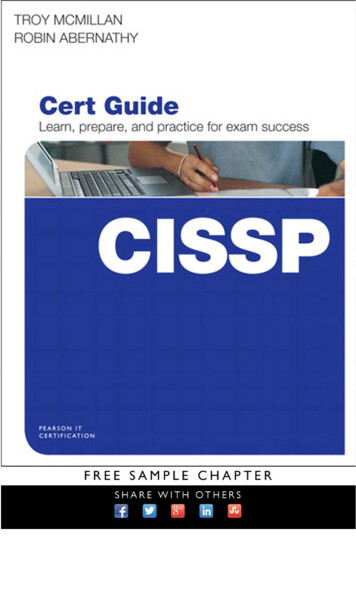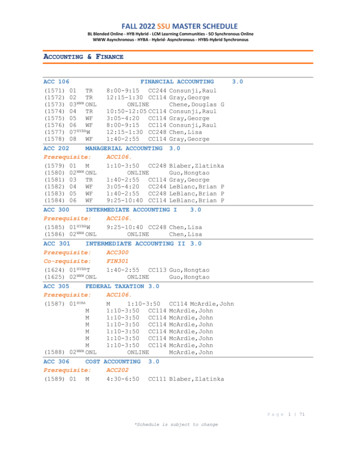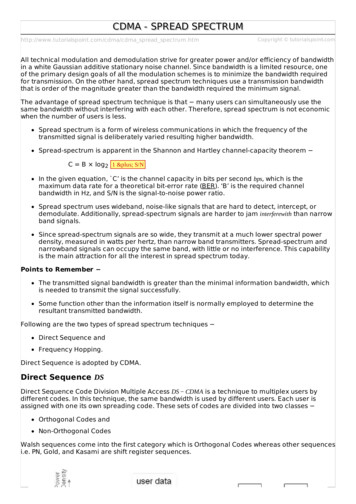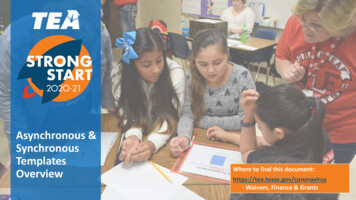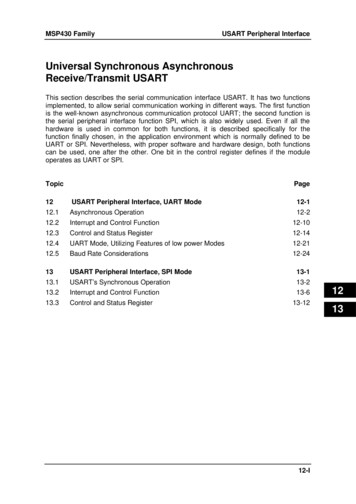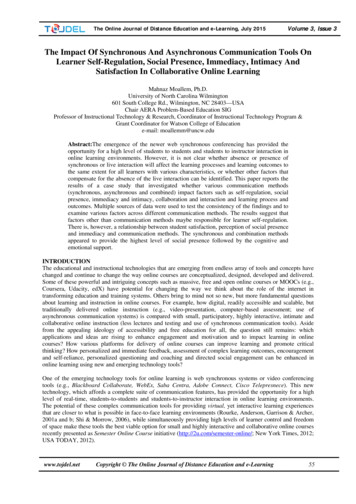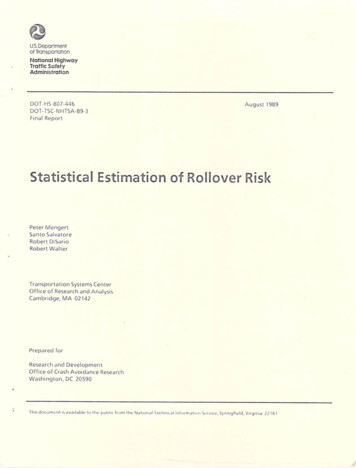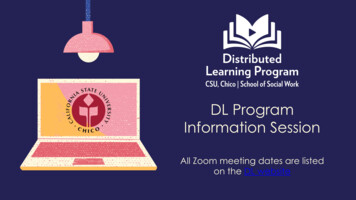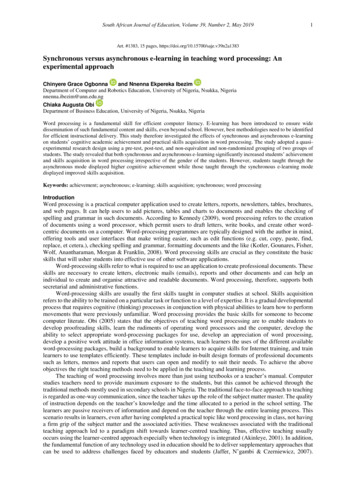
Transcription
South African Journal of Education, Volume 39, Number 2, May 20191Art. #1383, 15 pages, s versus asynchronous e-learning in teaching word processing: Anexperimental approachChinyere Grace Ogbonnaand Nnenna Ekpereka IbezimDepartment of Computer and Robotics Education, University of Nigeria, Nsukka, Nigeriannenna.ibezim@unn.edu.ngChiaka Augusta ObiDepartment of Business Education, University of Nigeria, Nsukka, NigeriaWord processing is a fundamental skill for efficient computer literacy. E-learning has been introduced to ensure widedissemination of such fundamental content and skills, even beyond school. However, best methodologies need to be identifiedfor efficient instructional delivery. This study therefore investigated the effects of synchronous and asynchronous e-learningon students’ cognitive academic achievement and practical skills acquisition in word processing. The study adopted a quasiexperimental research design using a pre-test, post-test, and non-equivalent and non-randomized grouping of two groups ofstudents. The study revealed that both synchronous and asynchronous e-learning significantly increased students’ achievementand skills acquisition in word processing irrespective of the gender of the students. However, students taught through theasynchronous mode displayed higher cognitive achievement while those taught through the synchronous e-learning modedisplayed improved skills acquisition.Keywords: achievement; asynchronous; e-learning; skills acquisition; synchronous; word processingIntroductionWord processing is a practical computer application used to create letters, reports, newsletters, tables, brochures,and web pages. It can help users to add pictures, tables and charts to documents and enables the checking ofspelling and grammar in such documents. According to Kennedy (2009), word processing refers to the creationof documents using a word processor, which permit users to draft letters, write books, and create other wordcentric documents on a computer. Word-processing programmes are typically designed with the author in mind,offering tools and user interfaces that make writing easier, such as edit functions (e.g. cut, copy, paste, find,replace, et cetera.), checking spelling and grammar, formatting documents and the like (Kotler, Gounares, Fisher,Wolf, Anantharaman, Morgan & Franklin, 2008). Word processing skills are crucial as they constitute the basicskills that will usher students into effective use of other software applications.Word-processing skills refer to what is required to use an application to create professional documents. Theseskills are necessary to create letters, electronic mails (emails), reports and other documents and can help anindividual to create and organise attractive and readable documents. Word processing, therefore, supports bothsecretarial and administrative functions.Word-processing skills are usually the first skills taught in computer studies at school. Skills acquisitionrefers to the ability to be trained on a particular task or function to a level of expertise. It is a gradual developmentalprocess that requires cognitive (thinking) processes in conjunction with physical abilities to learn how to performmovements that were previously unfamiliar. Word processing provides the basic skills for someone to becomecomputer literate. Obi (2005) states that the objectives of teaching word processing are to enable students todevelop proofreading skills, learn the rudiments of operating word processors and the computer, develop theability to select appropriate word-processing packages for use, develop an appreciation of word processing,develop a positive work attitude in office information systems, teach learners the uses of the different availableword-processing packages, build a background to enable learners to acquire skills for Internet training, and trainlearners to use templates efficiently. These templates include in-built design formats of professional documentssuch as letters, memos and reports that users can open and modify to suit their needs. To achieve the aboveobjectives the right teaching methods need to be applied in the teaching and learning process.The teaching of word processing involves more than just using textbooks or a teacher’s manual. Computerstudies teachers need to provide maximum exposure to the students, but this cannot be achieved through thetraditional methods mostly used in secondary schools in Nigeria. The traditional face-to-face approach to teachingis regarded as one-way communication, since the teacher takes up the role of the subject matter master. The qualityof instruction depends on the teacher’s knowledge and the time allocated to a period in the school setting. Thelearners are passive receivers of information and depend on the teacher through the entire learning process. Thisscenario results in learners, even after having completed a practical topic like word processing in class, not havinga firm grip of the subject matter and the associated activities. These weaknesses associated with the traditionalteaching approach led to a paradigm shift towards learner-centred teaching. Thus, effective teaching usuallyoccurs using the learner-centred approach especially when technology is integrated (Akinleye, 2001). In addition,the fundamental function of any technology used in education should be to deliver supplementary approaches thatcan be used to address challenges faced by educators and students (Jaffer, N’gambi & Czerniewicz, 2007).
2Ogbonna, Ibezim, ObiConsequently, interactive automated learner-centredmethods like e-learning have been introduced andadopted. E-learning is the use of electronic media,and technologies in education (Nichols, 2007). Itrefers to the use of modern technology, such ascomputers, digital technology, networked digitaldevices (such as the Internet) and associatedsoftware and courseware to facilitate the learningprocess (Clover, 2017; Food and AgricultureOrganization of the United Nations [FAO], 2011).Two basic methodologies are used in e-learning,namely asynchronous and synchronous learning.Synchronous learning involves the exchangeof ideas and information with one or moreparticipants during the same period. It facilitatesefficient education and provides both students andteachers with various ways of networking andsharing and collaborating in real-time (Higley,2013). In e-learning environments, examples ofsynchronous communication include online, realtime, live teacher instruction and feedback, Skypeconversations, chat rooms, and virtual classroomswhere everyone is online and workingcollaboratively at the same time (FAO, 2011).Asynchronous learning is self-paced and allowsparticipants to engage in the exchange of ideas orinformation without depending on otherparticipants’ simultaneous involvement (Boumans,2004; Safavi, 2008). In asynchronous learning onemay use applications such as email, blogs, wikis,discussion boards, web-supported textbooks,hypertext documents, audio or video courses andsocial networking using Web 2.0. Learners completecourse work, discussions, questions, et cetera intheir own time (Smith, 2009).Instructors provide materials, lectures, tests,and assignments that can be accessed at any time.Students may be given a timeframe, usually a oneweek window, during which they need to connect atleast once or twice. However, students are free tocontribute whenever they choose (eLearners.com,2014). In asynchronous learning, students proceed attheir own pace. If they need to listen to a lecture asecond time, or think about a question for a while,they may do so without fear of holding back the restof the class (Hrastinski, 2008).Furthermore, through e-learning education istaken out of the classroom. It is therefore necessaryto determine the best e-learning method for teachingword processing to obtain the desired results. Sinceword processing provides the necessary skills forsomeone to become computer literate, efforts shouldbe made to enhance the way in which these skills areimparted to help students overcome the challengesof computer illiteracy. It is worth noting that thelevel at which students achieve in any subject isdirectly proportional to the teaching method used,especially in those topics that involve the acquisitionof skills (Ganyaupfu, 2013; Tejedo-Romero, Rosa,Corcoles & Ponce, 2015). The aim of this study wasto determine the effects of synchronous andasynchronous e-learning modes on students’cognitive achievement and practical skillsacquisition in word processing to determine the bestpractice in teaching word processing throughe-learning.The Concept of E-LearningE-learning is understood differently by differentpeople. However, it is generally considered as onlinelearning. According to Boumans (2004) e-learningas an umbrella term describes any type of learningthat depends on or is enhanced by electroniccommunication using the latest information andcommunication technologies (ICT). It is alsodefined as a generic term covering a wide range ofICT technology-based applications and processes,including computer-based learning, web-basedlearning, virtual classrooms, digital collaborationand networking (Hambrecht, 2000). Garrison andKanuka (2004) define e-learning as web-enabledteaching and learning. E-learning can be defined aslearning facilitated and supported by usinginformation and communications technology. It cancover a spectrum of activities, from the use oftechnology to support learning as part of a blendedapproach (a combination of traditional ande-learning approaches), to learning deliveredentirely online (Jisc, 2016).E-learning encompasses several forms. In thefirst instance, e-learning takes the form of a meansof communication (Boumans, 2004) as it supportscommunication between students, teachers, tutors orpeers. Users can share resources and co-ordinatework processes and procedures, such as who doeswhat, when and how. Secondly, e-learning is usedfor simulation. It is used to simulate real-worldenvironments, thus linking the theoretical andpractical worlds. For example, students may usesimulations to prepare themselves for practicalsessions, to reflect on and repeat specific activities,and to simulate real-life practice in instances wherethese do not exist. Thirdly, e-learning is used as ageneral resource, which involves computers andInternet-based resources and services that allowstudents to learn through interactive e-learning unitsand rich media sources, using speech, video,interactive sequences or instruction. Students mayalso log onto available university intranets, learningportals or digital libraries from work or home.Fourthly, learning management systems (LMS) canbe used as e-learning platforms. Learningmanagement systems software deploys, manages,tracks and reports interactions between learners,learning content and the teacher. Learningmanagement systems, in combination with learningmanagement content systems (LMCS) can createcontent and provide storage. Learning managementcontent systems may serve as data repositorythrough which developers and subject experts may
South African Journal of Education, Volume 39, Number 2, May 2019share content and subject components over acomputer network.E-learning includes content (curriculum) andinstruction (pedagogy). E-learning is a neweducation model that may incorporate ecosystems ofnetworked communities and varieties of learningresources. Safavi (2008) asserts that e-learningemerged from two broad terms – “informationtechnology” and “education and training.” Thismeans that to transform a normal classroom lessoninto e-learning requires some expertise andorganization. In e-learning technology is a tool thatteachers may use in the new environment to impactstudent learning and outcomes. When usingtechnology, teachers need to consider how it mayprovide a solution to a specific problem in a learningenvironment (Nguen, Rienties, Toetenel, Ferguson& Whitelock, 2017). For instance, the use ofe-readers can solve the challenge of inadequatetextbooks and not understanding big ideas orconcepts, while the use of simulations can helpstudents working alone or in groups to seeimmediate outcomes when they manipulate theenvironment. Instead of just being taught theories,learners also experience the theory, which enhanceslearning and retention of knowledge (Nsa, Akpan &Williams, 2012). Although online training is aworthwhile approach for instruction, trainingpackages should not be delivered indirectly(Rosenberg, 2001). Structure may vary, but learners’requirements and the learning situation shouldalways take precedence. Rosenberg further remarksthat not all corporations are ready to deliver trainingby digital means. Successful digital training dependson support and several factors such as a culture’sreadiness and openness to comprehensively shareinformation, management’s readiness to investresources to develop robust infrastructure, and thetrainers’ readiness to design a learner-centredcurriculum based on employees’ ever-expandingneeds (Ssekakubo, Suleman & Marsden, 2011).Moreover, these concerted efforts for e-learningsuccess is needed more in developing countrieswhere various factors militate e-learning initiatives(Bhuasiri, Xaymoungkhoun, Zo, Rho & Ciganek,2012).E-Learning Application ReviewsThe most direct impact of e-learning would probablybe on students’ learning achievement (Safavi, 2008).The results from various studies show that thecomplex effects are closely related to howtechnology is used as an educational tool. Thisshows that using technology in teaching is no simplesolution to improving learning. Kozma (2005)reports that empirical studies on the impact of ICTshow no consistent relationship between theavailability of technology and student learning.Kulik (2003) analysed studies to identify howe-learning impacted student outcomes. The results3show that students who used computer tutorials inMathematics, Natural Science and Social Science,and those who use simulation software in Science,score significantly higher in tests than the studentswho do not use computers. The use of computerbased laboratories alone, however, did not result inhigher scores. The study further revealed that pupilswho read using tutorial software scored higher inreading, and those who used word processorsachieved better scores in writing skills. Incomparing asynchronousandsynchronouse-learning effects on students, Hrastinski (2008)asserts that asynchronous e-learning makes itpossible for learners to access e-learningenvironments at any time to download documents orrespond to teachers or peers. This allows students tospend more time refining their contributions to bemore thoughtful and productive. Synchronouscommunication, on the other hand, enhances thedevotion and interest of the learner in a task. It hasbeen observed that e-learning resulted in lowerachieving students becoming more engaged in theirlearning. In an earlier study in Kenya learners in tworandomly selected Physics classes used computerbased instruction while a third equivalent group didnot. At the end of the lessons the students who usedcomputers had learned physics concepts better andwere more positive about their learning of Physics(Kulik, 2003). This corroborates Bosch’s (2009)findings on the exploration of student’s use ofweb-based learning and lecturer engagement withstudents via social media. The study revealed thepositive benefits of using web-based learning –especially in the development of educational microcommunities. Consequently, Ssekakubo et al.(2011) who sought to determine whether e-learningsystems had fulfilled their potential in developingcountries, recommend additional research towards amore effective deployment of learning systems.Theoretical FrameworkThe theory of constructivism upholds that people’sexperiences enable them to build an understandingand connotation of concepts (Bruner, 1990).Applying this theory in learning suggests that whenlearners acquire new information, the tendency is tolink that information to related existing informationor experience in memory, thereby forming their ownsubjective mental image of the informationacquired. One of the primary goals of constructivisttheories of teaching is that students learn throughreceiving training to take initiative when it comes totheir own learning experiences, instead of relying onsomeone else’s information (Bruner, 1996). Thispoint of view corroborates that e-learning,stimulates students’ active participation in learningactivities through electronic media.An increasing body of literature shows thatstudents learn better when actively involved with thecurriculum and learning content through
4Ogbonna, Ibezim, Obitechnology. Teachers should thus develop curriculathat engage students with hands-on, inquiry-basedlearning. Students develop higher-order thinkingand problem-solving skills by using computer-basedstrategies. Students who participate in real-lifeapplications draw analogies, infer relationships,predict outcomes and analyse data. E-learning hasbeen proven to enhance learning (Hrastinski, 2008;Ssekakubo et al., 2011; Tang, 2002; Udofia & Udofia, 2013), however, this paper presents the comparative effects of the two e-learning methodologies(synchronous and asynchronous) on students’ academic achievement in learning word processing.Specifically, the study aimed to determine:1. the effects of synchronous and asynchronous e-learning on students’ cognitive achievement in word processing2. the effects of synchronous and asynchronous e-learning on students’ practical skills acquisition in wordprocessing3. the influence of gender on students’ practical skillsacquisition in word processing when taught throughsynchronous and asynchronous e-learning.Research Questions1. What effects do the two e-learning modes have onstudents’ cognitive achievement in word processing?2. What effects do the two e-learning modes have onstudents’ practical skills acquisition in word processing?3. What influence does gender have on students’ practical skills acquisition when taught word processingthrough synchronous and asynchronous e-learning?HypothesesHo1: There is no significant difference (p 0.05) instudents’ cognitive achievement in word processinglearnt through synchronous or asynchronouse-learning.HA1: There is a significant difference (p 0.05)in students’ cognitive achievement in word processing learnt through synchronous or asynchronouse-learning.Ho2: There is no significant difference(p 0.05) in students’ practical skills acquisition inword processing learnt through synchronous orasynchronous e-learning.HA2: There is no significant difference(p 0.05) in students’ practical skills acquisition inword processing learnt through synchronous orasynchronous e-learning.HO3: Gender has no substantial interaction effect (p 0.05) on students’ mean cognitive achievement scores in word processing learnt through synchronous and asynchronous e-learning.HA3: Gender has a substantial interaction effect(p 0.05) on students’ mean cognitive achievementscores in word processing learnt through synchronous and asynchronous e-learning.MethodThe study adopted a quasi-experimental design inwhich pre- and post-tests were administered to twonon-equivalent and non-randomised groups ofstudents. The study was conducted in two secondaryschools in Nsukka, Enugu State, Nigeria. A sampleof 70 junior secondary school one (JSS1) students ofages 10–12, comprising of two intact classes fromthe two schools, was used for the study. Twoinstruments were developed for the study: a wordprocessing cognitive achievement test (WPCAT)(see Appendix A), and a word processing skillacquisition test (WPSAT) (see Appendix C). TheWPCAT consisted of 40 multiple choice questionswith four alternative answers each. The WPSATconsisted of five instructions. Both tests wereadministered prior to the teaching intervention andagain, with the questions of the WPCAT presentedin a different order (see Appendix B), after. Everycorrect answer in the WPCAT was awarded 2.5points, while an incorrect answer was awarded nopoints. Students’ level of performance was ratedaccording to the rating scale for the word processingskills acquisition test (RSWPSAT) developed by theresearchers (see Appendix D). The data collectioninstruments were subjected to face and contentvalidation. Kuder-Richardson 21 (KR-21) was usedto establish the stability of the achievement testitems, which resulted in a reliability coefficient of0.95, while Kendall’s W Test was used to establishthe reliability of the skills acquisition, whichresulted in a coefficient of 0.94.The study was conducted during normal schoollesson periods according to the class timetable forJSS1. The regular computer studies teachers wereused to teach the learning content used in the study.The researchers tutored these teachers on what wasexpected of them during a one-day workshop. Thestudy involved two groups of students. Experimentalgroup 1 comprised of 36 students who were taughtthrough synchronous e-learning, and experimentalgroup 2 comprised of 34 students who were taughtthrough asynchronous e-learning. Experimentalgroup 1 was taught according to a synchronouse-learning lesson plan developed by the researchers.They received the lesson in a virtual classroomsituation, where computer systems and a multimediaprojector were used as learning resources.Experimental group 2 used computers to accessinteractive asynchronous e-learning lessons ondigital versatile discs (DVDs) as learning resources.The students’ age and class, the lesson duration, thespecific objectives of the learning module and itsrelation to the lesson topics were considered in thepreparation of the lesson plans. The content coveredin the lesson plans included the following:definitions of word processing; uses and examplesof word processors, loading and exiting wordprocessor programs, retrieving, creating, formatting,editing and saving files. The students were taught fortwo lesson periods of 45 minutes per week, for threeweeks (this being the duration for teaching word
South African Journal of Education, Volume 39, Number 2, May 2019processing to junior secondary school one students).After the intervention the word processingcognitive achievement test (WPCAT) and the wordprocessing skills achievement test (WPSAT) wereonce again administered by the teachers who taughteach of the groups. The researchers marked theWPCAT scripts to obtain the students’ achievementscores after the intervention, while the teachers usedthe RSWPSAT to rate the students’ post-teachingperformance on the specific tasks/skills. The scorescollected from the two groups were analysed toanswer the research questions and test thehypotheses.Data collected from the administration of thepre- and post-tests was analysed using mean (X) andstandard deviation (SD). The mean gain of each ofthe groups was computed to determine the effect ofsynchronous and asynchronous e-learning onstudents’ achievement and skills acquisition in wordprocessing studies. To test the hypothesesformulated for the study at 0.05 level ofsignificance, analysis of covariance (ANCOVA)5statistic was used.ResultsData collected for answering the research questionsand testing the hypothesis are presented in Tables 1–4.Data presented in Table 1 shows that thestudents who were taught word processing throughsynchronous e-learning achieved a mean score of47.00 in the pre-test, a mean score of 60.70 in thepost-test a gain mean score of 13.70. The data alsoshows that students who were taught wordprocessing through the asynchronous e-learningmode achieved a mean score of 40.81 in the pre-test,a mean score of 66.62 in the post-test and a gainmean score of 25.81. This result indicates thatteaching word processing using synchronous andasynchronous e-learning appreciably increasedstudents’ cognitive word processing achievement.However, students taught through asynchronouse-learning achieved higher than the group taughtthrough synchronous e-learning.Table 1 Pre-test and post-test cognitive achievement mean scores of students exposed to synchronous andasynchronous e-learning in word processingPre-/post-testPre-testGroup scoresSynchronous modeAsynchronous modeN3634XSD47.00 10.2040.81 11.46Post-testX60.7066.62SD13.149. 55Data from Table 2 reveals that the studentstaught word processing through synchronous elearning achieved a pre-test skills acquisition meanscore of 29.72, a post-test mean score of 55.00, anda skills acquisition gain mean score of 25.28.Students who were taught word processing throughasynchronous e-learning achieved a pre-test skillsacquisition mean score of 30.59, a post-test skillsacquisition mean score of 53.53 and a mean skillsGain13.7025.81acquisition gain score of 22.94. This result showsthat teaching word processing using synchronousand asynchronous e-learning considerably increasedstudents’ practical skills acquisition in wordprocessing, although the students who were taughtthrough synchronous e-learning showed slightlyhigher practical skills acquisition than the grouptaught through asynchronous e-learning.Table 2 Pre-test and post-test practical skills acquisition mean scores of students exposed to synchronous andasynchronous e-learning in word processingPre-testNSynchronous mode36Asynchronous mode post-test groupSD9.719.58Gain scores25.2822.94Table 3 Pre-test and post-test practical skills acquisition mean scores of male and female students exposed tosynchronous and asynchronous e-learning in word 05SD10.289.629.6414.53The data in Table 3 shows the influence ofgender on the practical skills acquisition of studentstaught word processing using synchronous 80Gain scores23.4624.4024.1622.27asynchronous e-learning. The result reveals thatmale students who were taught word processingthrough synchronous e-learning achieved a pre-test
6Ogbonna, Ibezim, Obiachievement mean score of 29.72, a post-testachievement mean score of 53.18, and an achievement mean score gain of 23.46. Female studentswho were taught word processing through synchronous e-learning achieved a pre-test achievementmean score of 30.00, an achievement mean score of54.40, and an achievement mean score gain of24.40.Male students who were taught word processing through asynchronous e-learning achieved apre-test skills acquisition mean score of 27.92, apost-test mean skills acquisition score of 52.08, anda skills acquisition mean gain of 24.16. Female students who were taught word processing throughasynchronous e-learning achieved a pre-test skillsacquisition mean score of 32.05, a post-test skills acquisition mean score of 54.32, and a skills acquisition mean gain of 22.27. These results indicate thatstudents’ gender has a slight influence on their practical skills acquisition when taught through synchronous and asynchronous e-learning.The results in Table 4 show that for the test ofsignificant difference between the learning modes(group), the F-cal is 1.645 and significant value is0.204, which is a level of significance greater than0.05. This indicates that there was no significant difference in students’ cognitive word processingachievement scores after learning through synchronous or asynchronous e-learning. This is confirmedby the partial eta squared value (0.024) showing anon-significant percentage variance (2.4%) in thedependent variable (cognitive mean achievementtest scores), which can be explained by the independent variable (learning modes). Therefore, thenull hypothesis (Ho1) was upheld.The data presented in Table 5 shows that in thetest of significant difference between the learningmodes (group), F-cal is 1.558 with a significantvalue of 0.216, which is greater than the 0.05 levelof significance. This indicates that there is nosignificant difference in the practical skillsacquisition mean scores of the students taughtthrough synchronous and asynchronous e-learning.This is confirmed by the partial eta squared value(0.023) showing a non-significant percentagevariance (2.3%) in the dependent variable (practicalskills acquisition test scores) that can be explainedby the independent variable (learning modes).Therefore, the null hypothesis (H02) was upheld.Table 4 ANCOVA for test of significance in the cognitive mean achievement scores of students in wordprocessing re: learning modesSourceType III SS dfMSFCorrected model33.803a1 33.8031.645Intercept16148.8171 48.817 786.087Group33.8031 33.8031.645Error1376.40067Total17541.000 69 20.543Corrected total1410.20368Note. aR-squared .024 (Adjusted R-squared .009).Sig.204.000.204Partial eta squared.024.921.024Table 5 ANCOVA for test of significance in the practical skills acquisition mean scores of students in wordprocessing: learning modesSourceType III SSCorrected roup4.68214.682Error201.261673.004Total62186.000 69Corrected total205.94268Note. aR-squared .023 (Adjusted R-squared .008).F1.55820634.1411.558The data presented in Table 6 shows that theinteraction effect between the groups and gender(group *gender), F-cal is 0.30 with a significantvalue of 0.864, which is greater than the 0.05 levelof significance. This indicates that there is nosignificant interaction effect between male andfemale students’ practical skills acquisition meanscores in word processing taught through the twoSig.216.000Partial eta squared.023.997.216.023learning modes. This is confirmed by the partial etasquared value (0.020) showing a non-significantpercentage variance (2.0%) in the dependentvariable (practical skills acquisition test scores) thatcan be explained by the independent variable(learning modes and gender), therefore, upholdingthe null hypothesis (HO3). pa
dissemination of such fundamental content and skills, even beyond school. However, best methodologies need to be identified for efficient instructional delivery. This study therefore investigated the effects of synchronous and asynchronous e-learning on students' cognitive academic achievement and practical skills acquisition in word processing.
